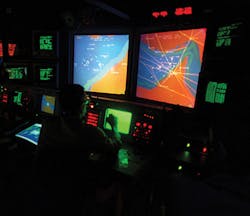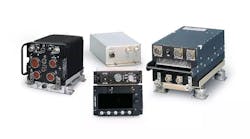ARLINGTON, Va. - Officials at the U.S. Defense Advanced Research Projects Agency (DARPA) in Arlington, Va., announced a $13.4 million contract modification to BAE Systems Electronic Systems in Merrimack, N.H., for phase-three of the Adaptive Radar Countermeasures (ARC) program.
The ARC program seeks to develop electronic warfare (EW) capabilities to identify, characterize, and adapt to advanced, complex radar. The program uses machine learning to learn in real time what adversary radar is doing and create a new jamming profile on-the-fly. The program's goal is to develop ways of countering adaptive radar threats quickly based on over-the-air observable signals.
Threats of particular interest include ground-to-air and air-to-air phased array radars capable of performing several different functions, such as surveillance, cued target acquisition, tracking, non-cooperative target identification, and missile tracking. These radar systems are agile in beam steering, waveform, coding, and pulse repetition interval. Key challenges to the ARC contractors are how to isolate signals clearly amid hostile, friendly, and neutral signals; figuring out the threat the signal poses; and jamming the signal.
Modern enemy radar systems are becoming digitally programmable with unknown behaviors and agile waveforms, so identifying and jamming them is becoming increasingly difficult. Things will get worse in the future as radars develop the ability to sense their environment and adapt their transmission characteristics and pulse processing algorithms to defeat attempts to jam them.
BAE Systems engineers completed algorithm development and component-level testing in phase-one of the ARC program. In the second phase, they completed algorithm integration into an EW payload along with extensive hardware-in-the-loop testing involving thousands of tests against advanced closed-radar simulators.
Now BAE Systems experts move into the third and final phase of the DARPA ARC program in which they will work to increase the complexity and realism of ARC testing. The program is expected to be complete in 2018, and then BAE Systems and U.S. military experts will move ARC-developed technologies into existing EW systems. BAE Systems originally won a 30-month, $36.7 million ARC phase-one contract in March 2013.
In addition to BAE Systems, ARC phase-one contractors are Leidos in Reston, Va.; Vadum Inc. in Raleigh, N.C.; Helios Remote Sensing Systems Inc. in Rome, N.Y.; Michigan Tech Research Institute (MTRI) in Ann Arbor, Mich.; and Systems and Technology Research (STR) in Woburn, Mass.
The six ARC contractors will work to enable EW systems to generate effective countermeasures automatically against new, unknown, or ambiguous radar signals in near real time.
The program will develop a closed-loop system with signal analysis and characterization, countermeasure synthesis, and countermeasure effectiveness assessment. The system not only will be able to learn automatically to counter new radar threats, but also will enable human operators to command and receive feedback from the system.
The ARC program should be able to isolate agile unknown radar threats in dense, complex electromagnetic environments with friendly, hostile and neutral RF emitters; counter these new radar threats; provide real-time feedback on countermeasure effectiveness; counter several threats at once; support single-platform or distributed, multi-platform operations; support autonomous and human-in-the-loop operation; and use a standards-based, modular, open, and extensible software architecture. The system should also store and download new knowledge and countermeasures for post-mission analysis.
BAE Systems will do the work in Nashua, N.H., and Burlington, Mass., and should finish by June 2018.
FOR MORE INFORMATION visit BAE Systems Electronic Systems online at www.baesystems.com.




